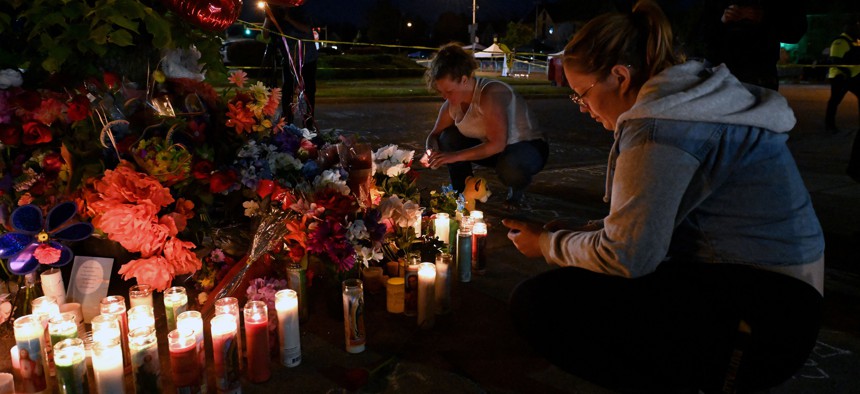States Have Leading Role to Play in Preventing Mass Shootings

Memorial near a Tops Grocery store in Buffalo, New York, on May 15, 2022, the day after a gunman shot dead 10 people. Getty Images/USMAN KHAN
COMMENTARY | Embracing coordinated violence prevention strategies can help state governments prevent targeted violence.
Attacks like those in Buffalo, New York and Uvalde, Texas evoke a paradoxical mix of immediate disbelief and dread that yet another mass shooting feels inevitable. As the nation grapples with what to do, there are vehement calls for federal action on gun control, better access to mental health care and more effective law enforcement.
This debate is currently focused on Washington, D.C. While federal action may be needed, it is state governments that might be best positioned to take the lead on long-term, sustainable efforts to prevent targeted violence.
Today, multiple organizations across the United States engage in specialized violence prevention efforts. Some organizations conduct active bystander trainings and teach communities and schools about recognizing threats. Others implement trauma recovery programming and wraparound services for youth at risk. And others work on helping people disengage from hate groups.
While important and commendable, these efforts are often disjointed, underfunded and inaccessible to many who could benefit from them the most. We have interviewed dozens of practitioners in the field of violence prevention, and they repeatedly tell us that existing services do not come together in any sort of broader violence prevention strategy.
Disjointed efforts means limited effectiveness. To create sustainable change, all the pieces of the violence prevention puzzle must be in place. According to the well-established public health model of violence prevention, these pieces include direct work with the individuals at risk and those who have committed violent acts in the past, as well as community initiatives to foster resilience and awareness. These programs must reflect their local contexts and be well coordinated, so that all communities and individuals can receive the services they need.
What States Can Do
This presents a strong opening for state governments. Unlike the federal government, states are better equipped to understand their local communities and can bring local stakeholders together. Unlike many municipalities, states may be better able to marshal significant resources and funds. States also can give a community-level lens to research-backed expertise and rally the diverse resources needed to address this crisis.
We recently developed a resource for the National Governors Association that outlines the roles states can play in targeted violence prevention.
Convene stakeholders. Most importantly, states can convene stakeholders, experts and community leaders to develop an overarching violence prevention strategy. Then states can secure and provide the financial and knowledge resources needed to implement it.
Elevate data-driven approaches. States can map existing violence prevention efforts. Where there are gaps, states can foster organizations’ ability to design programs that have clear goals and the capacity to achieve them. States can evaluate efforts and monitor progress.
Protect civil rights and privacy. States can serve as a guarantor of civil rights and privacy protections. Many communities understandably distrust government-initiated efforts as the legacy of earlier controversial surveillance practices in the name of countering violent extremism. States can make sure that the targeted violence prevention strategy has built-in checks to prevent marginalized communities and minority groups from being stigmatized, subject to greater surveillance, or persecution based on their religious or ethnic identification or country of origin. By elevating the voice of minority groups, states can help ensure that all communities benefit equally from prevention initiatives.
This is not designed as a top-down approach dictated by statehouses. States must play a neutral, facilitatory role by serving as coordinators of a multifaceted effort by government and nongovernment actors.
Building a culture of peace demands a systematic, scrupulous and thorough effort—but it is achievable. Targeted violence takes lives and shatters communities. State governments can take proactive steps to help ensure that we build the future where that is not an inevitability.
Dr. Katya Migacheva is a social scientist at the RAND Corp., where her research focuses on the drivers and prevention of violent extremism, intergroup conflict, disinformation and challenges in societies undergoing transition. Jordan Reimer is a policy analyst at the RAND Corp., where he focuses on targeted violence and terrorism prevention, countering disinformation and Middle East security.
NEXT STORY: For Mental Crises, Send a Pro Not the Police





